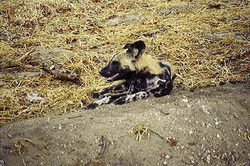African Wild Dog

Pronunciation
African Wild DogDescription
The African Wild Dog has spotted coloration on their coat. It is sufficiently unique that no two animals have the same pattern. They have very good eye site and, unlike other canids, they hunt only by sight and not by scent. Their body is thin and strongly muscled with long, thin legs. Their ears are large and pointed upright. Temperament
The African Wild Dog is not a domesticated dog. They live in the wild and in zoos. Inside their dog packs they have strong family bonds headed by alpha male and alpha female. They live in stable groups of related males with related females leaving to join a different pack at 14 to 30 months old. Pups are given priority at feeding; adults wait until youngsters have finished. They all cooperate with each other when hunting, following the direction signals of the alpha male. Hunting occurs around dawn and dusk. Gestation is approximately 70 days with a litter of 6 to 10 puppies. Pups can begin eating regurgitated solid food at about 3 weeks. During the first 2 months the pups are protected by 1 to 2 adults when the pack is hunting. Pups are weaned in 10 to 12 weeks and reach sexual maturity between 12 to 18 months. In the wild, the African Wild Dog eats, gazelle, antelope, zebra, wart-hog and drink little water because they receive adequate amounts from blood of prey. In captivity, such as a zoo, they eat dried dog food and bones.Height, Weight
Length of body is 30 - 40 inches (71 - 85 cm.)
The tail is 12-16 inches (31-41cm.) long.
Weight: 44 to 60 pounds (20.5 - 27 kg.)Health Problems
-Living Conditions
The African Wild Dog live outdoors. They are an undomesticated breed living in Africa and in zoos.Exercise
This wild dog has great endurance; on the final part of the hunt they can reach speeds of up to 37 mph.Life Expectancy
About 10 years.Grooming
-Origin
The African Wild Dog is considered an endangered species. They can be found in Africa south of the Sahara Desert in areas of semi-desert to mountainous and in zoos.
African Wild DogDescription
The African Wild Dog has spotted coloration on their coat. It is sufficiently unique that no two animals have the same pattern. They have very good eye site and, unlike other canids, they hunt only by sight and not by scent. Their body is thin and strongly muscled with long, thin legs. Their ears are large and pointed upright. Temperament
The African Wild Dog is not a domesticated dog. They live in the wild and in zoos. Inside their dog packs they have strong family bonds headed by alpha male and alpha female. They live in stable groups of related males with related females leaving to join a different pack at 14 to 30 months old. Pups are given priority at feeding; adults wait until youngsters have finished. They all cooperate with each other when hunting, following the direction signals of the alpha male. Hunting occurs around dawn and dusk. Gestation is approximately 70 days with a litter of 6 to 10 puppies. Pups can begin eating regurgitated solid food at about 3 weeks. During the first 2 months the pups are protected by 1 to 2 adults when the pack is hunting. Pups are weaned in 10 to 12 weeks and reach sexual maturity between 12 to 18 months. In the wild, the African Wild Dog eats, gazelle, antelope, zebra, wart-hog and drink little water because they receive adequate amounts from blood of prey. In captivity, such as a zoo, they eat dried dog food and bones.Height, Weight
Length of body is 30 - 40 inches (71 - 85 cm.)
The tail is 12-16 inches (31-41cm.) long.
Weight: 44 to 60 pounds (20.5 - 27 kg.)Health Problems
-Living Conditions
The African Wild Dog live outdoors. They are an undomesticated breed living in Africa and in zoos.Exercise
This wild dog has great endurance; on the final part of the hunt they can reach speeds of up to 37 mph.Life Expectancy
About 10 years.Grooming
-Origin
The African Wild Dog is considered an endangered species. They can be found in Africa south of the Sahara Desert in areas of semi-desert to mountainous and in zoos.
